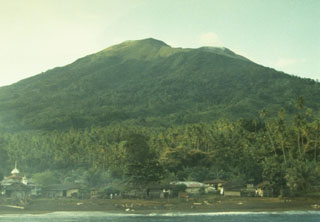Report on Gamkonora (Indonesia) — 2 March-8 March 2016
Smithsonian Institution / US Geological Survey
Weekly Volcanic Activity Report, 2 March-8 March 2016
Managing Editor: Sally Sennert.
Please cite this report as:
Global Volcanism Program, 2016. Report on Gamkonora (Indonesia) (Sennert, S, ed.). Weekly Volcanic Activity Report, 2 March-8 March 2016. Smithsonian Institution and US Geological Survey.
Gamkonora
Indonesia
1.38°N, 127.53°E; summit elev. 1635 m
All times are local (unless otherwise noted)
PVMBG reported that observers at the Gamkonora observation post in Gamsungi (6 km NW), West Halmahera, reported that during 1 January-6 March diffuse white plumes rose up to 150 m above the crater rim, although weather conditions often obscured views. RSAM values fluctuated; higher values during mid-January through February were due to increased tremor and tornillo-type earthquakes. The Alert Level remained at 2 (on a scale of 1-4). Residents and tourists were asked not to venture near the crater within a radius of 1.5 km.
Geological Summary. The shifting of eruption centers on Gamkonora, the highest peak of Halmahera, has produced an elongated series of summit craters along a N-S trending rift. Youthful-looking lava flows originate near the cones of Gunung Alon and Popolojo, south of Gamkonora. Since its first recorded eruption in the 16th century, typical activity has been small-to-moderate explosive eruptions. Its largest recorded eruption, in 1673, was accompanied by tsunamis that inundated villages.
Source: Pusat Vulkanologi dan Mitigasi Bencana Geologi (PVMBG, also known as CVGHM)

